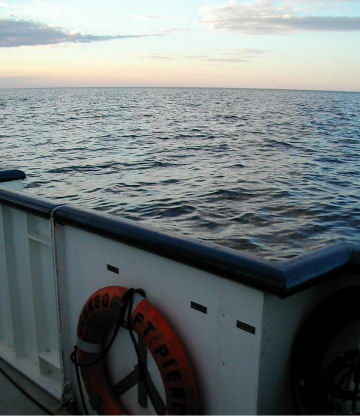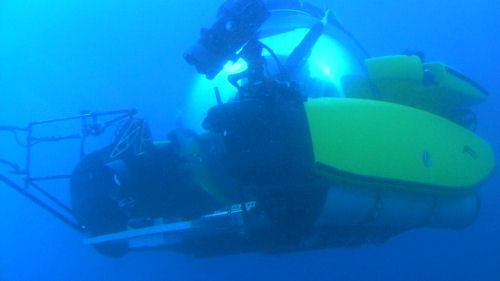Just how big are the oceans as a habitat?
"The ocean: the largest habitat on Earth" - those words, spoken by Sir David Attenborough at the start of the "prequel" to Blue Planet II, capture the scope, focus, and justification for the BBC Natural History Unit's latest landmark series.
But straightforward statements like that can be a head-scratcher for academics who fact-check these programmes. Over the past two years I've been a scientific adviser on some of the topics covered in a couple of episodes, while colleagues at the Open University have been academic partners for the whole series. That first line of the prequel in particular takes us down a rabbit-hole, to think about an often-heard statement in a different way.
Blue Planet II prequel (BBC Earth Youtube channel)
The oceans cover 71 percent of the surface of the Earth, so seafloor provides the largest area for species that scoot or root on our planet's surface – a reasonable justification for the "largest habitat on Earth". But what about lifeforms that can swim, fly, drift in wind or currents, or even thrive below the planet's surface?
In terms of volume, it's sometimes claimed that oceans provide 99 percent (or sometimes 97 percent) of the living space on our planet. But I'm really not so sure about that one, if we think about the "subsurface biosphere" of life within the rocks of the Earth's crust, and the aerial habitat in the skies above us.
The average depth of the ocean is 3441 metres, so taking 71 percent of the Earth's surface with that average depth gives us an estimated volume of 1332 million km3 for the oceans. And there is life swimming or drifting throughout that vast volume, even to the bottom of the deepest trenches nearly 11 km beneath the waves.

Those trench-dwellers are not the deepest lifeforms on our planet, however, as a "subsurface biosphere" of microbes permeates even further into the Earth's crust. There are microbes living 2.5 km below the ocean floor, for example, in coal-bearing sediments. The limit for subterranean life depends on local geology, however, and even assuming a limit of 2.5 km all around the world gives us a "subsurface biosphere" of around 1275 million km3. That's smaller than the oceans, and furthermore not all that volume is habitable, as the microbes are squeezed into spaces within the rocks.
There are also microbes in atmosphere above our heads, living in water droplets and on ice crystals in thunderclouds, up to an altitude of at least 12 km. But before we imagine a layer 12 km high for microbial life in the skies, it's worth remembering that they need a watery environment in which to thrive. Only around 0.4 percent of our atmosphere is water vapour, so the aerial habitat for microbial life is much less voluminous than we might think.
What about the aerial habitat for birds, bats, flying insects, and tiny animals? Bar-headed geese may fly at an altitude of more than 8 km in the Himalayas, but they don't actually fly 8 km above the ground – they follow the terrain of the mountain range as they migrate over it. So it may be wrong to assume a layer 8 km high for the aerial habitat of animal life around the world, as there are few mountains rising to those heights.
On 29 November 1973, however, an aircraft flying at an altitude of 11 km over the Ivory Coast collided with a Ruppell's Vulture, which holds the record for the highest known bird. As this took place over the coast, with no mountains below, we might therefore assume a layer at least 10 km high for animal life in the atmosphere, all over our world, which would give us an astonishing habitat of 5100 million km3 for airborne animal life. So at this point, our blue planet is perhaps starting look like a very airy one too.
But birds don't spend their whole lives on the wing - they have to land to nest, for example. Many of the inhabitants of the ocean's interior, in contrast, can drift for their whole lives without encountering a solid surface. So they really inhabit that ocean space to a greater extent than birds inhabit the air.

Where the ocean pips it, though, is in the abundance of life that it harbours. Microbes utterly outstrip animals and plants as the dominant form of life on Earth, in their individual numbers, so it's their abundance that matters here. And while living microbes are restricted to watery spots in the atmosphere, they face no such limitation in the ocean.
A single millilitre of surface seawater naturally contains around a million living bacteria and other kinds of single-celled microbes. Although that concentration drops off to perhaps ten thousand microbes per millilitre in most of the deep ocean, the total global population of microbes in the oceans is staggering: approximately 44 octillion living cells (or 44 000 000 000 000 000 000 000 000 000 if you prefer). That number is literally beyond astronomical: it's about ten thousand times the number of stars that astronomers estimate are in the observable Universe. So the oceans are certainly "the largest reservoir of life on Earth".
Is that the same as "the largest habitat on Earth"? The oceans really contain lots of different habitats, of course, from lush kelp forests to huge expanses of open water. Blue Planet II celebrates that reality in its forthcoming episodes, exploring places such as sunlit coral reefs and bizarre deep-sea brine pools, so I'm comfortable with that short-hand in its opening line. After four years of work by a small army of producers, camera people, sound recordists, editors, episode researchers, organisers, minisub pilots, ship crews, scientific advisers and many more, it's time to immerse ourselves in the wonder - and realise how we are connected to that vast reservoir of life.
Jon Copley, October 2017
A later version of this became an article published by The Conversation
| Previous | Index | Next |



